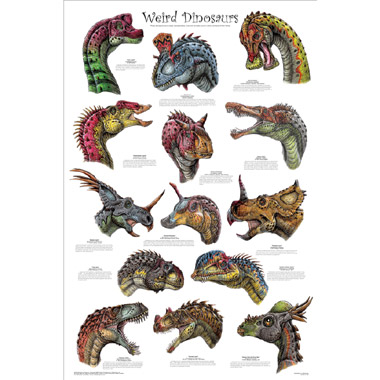Pretty Pachyrhinosaurs and Beautiful Horned Dinosaurs
Pachyrhinosaurs – Bizarre Horns and Bumps Designed to Attract a Mate
The horns, frills, crests and epoccipital bones of the ceratopsids (horned dinosaurs) have fascinated palaeontologists, none more so than the pachyrhinosaurs. This bizarre ornamentation has been taken to extremes in some genera, such as Styracosaurus with its huge frill of long spikes and Chasmosaurus with its broad, wide head-shield. However, the discovery of a large ceratopsid bone-bed in Canada may help scientists learn more about ceratopsian head gear.
The discovery of a new species of pachyrhinosaur – Pachyrhinosaurus lakustai found in Alberta, Canada may provide vital information regarding the growth and development of such ornamentation. Information on the ontogeny (growth and development) of dinosaurs is essential in helping to understand how this ornamentation developed as the animals grew.
New Species of Dinosaur (Pachyrhinosaurus)
To read an article on the discovery of this new species of pachyrhinosaur: New Species of Pachyrhinosaur named in honour of its Discoverer.
The horns, spikes and other bony elements making up the head-shields of these horned dinosaurs may look bizarre to us, but they must have evolved for a particular purpose, with adults passing on these characteristics to subsequent generations and Natural Selection operating to pass on beneficial characteristics.
An Illustration of Pachyrhinosaurs

Picture credit: Mike Fredericks
The illustration above shows two adult pachyrhinosaurs (Pachyrhinosaurus canadensis), scientists are unsure whether the large bump on the snout supported a horn and some illustrators have depicted pachyrhinosaurs with a small nose horn arrangement – such are the difficulties in interpreting the fossil record.
However, these scary faces may look very intimidating to us, but researchers studying the bone-bed in which this new species was found think that this ornamentation helped pachyrhinosaurs attract a mate.
A Bizarre-looking Dinosaur
Commenting on the species, Scott Sampson of the Utah Museum of Natural History, one of the scientists involved with the study stated:
“It’s one of the most bizarre-looking dinosaurs ever. It has more bony bells and whistles than just about any animal I’ve ever heard of”.
Around the edge of its large skull plate, referred to as a frill, is a series of forward-curving spikes, each about 1.5 feet (0.45 metres) long.
Despite their less-than-cuddly appearance, the team of North American researchers believe other pachyrhinosaurs would have found the sharp adornments and strange spikes appealing.
Philip Currie, a palaeontologist at the University of Alberta, added:
“it’s generally conceded that these horns on the face and the frill were to make [the dinosaurs] attractive to potential mates.”
Phil Currie led the team that produced the paper describing this new species of dinosaur. The discovery of at least 27 individuals of the same species, with importantly, 15 skulls within the bone-bed, has helped the team draw some conclusions related to the amazing head gear of these horned dinosaurs. Regarded as one of the richest bone-beds in the world, scientists estimated that there were over 300 bones per cubic metre of matrix. The animals excavated represented adults and juveniles of the same species, allowing the scientists to study the development of these facial structures as the animals grew into mature, breeding adults.
“Most dinosaur species are known from one or two typically incomplete specimens, whereas this species is from a massive bone bed that preserved the remains of dozens of individuals and a number of skulls, sampling it from juvenile to adult and showing us the real variation that occurs among a species,” said the Utah museum’s Sampson.
The group found large differences between young and old among these horned dinosaurs. The juveniles seemed to have been relatively smooth-faced, while the adults were spiky, Currie, the lead scientist, explained.
“It was the first really good example showing growth and variation in these animals, where we had the babies looking one way and the adults looking totally different,” Currie commented.
The discovery of so many dinosaurs of one species at one site enables scientists to gain a unique insight into dinosaur growth rates and ontogeny. The Pachyrhinosaurus find also helps to piece together the ceratopsid family tree. Although, a number of ceratopsid genera are known, scientists are unsure how they are all related.
Discussing the recent finds in Alberta, Canada, Phil Currie added:
“It’s part of a sequence where we can look at not only the animal itself but all its close relatives, and we’re reaching the point now where we can trace these things from formation to formation and see the evolutionary changes of the lineage.”
Sampson agreed that the new research stands to make a significant advance in the study of horned dinosaurs and their family tree, he referred to the bone-bed discovery as a “landmark” in horned dinosaur research.
Pretty Pachyrhinosaurs
To see a model of Pachyrhinosaurus and other horned dinosaur figures: Dinosaur Models and Toys.
A number of dinosaurs had some amazing adaptations that gave them a rather bizarre appearance. As well as the horned dinosaurs, there are the bone-headed dinosaurs known as the pachycephalosaurs and curious looking animals such as Cryolophosaurus, a theropod of the Early Jurassic nick-named “Elvisosaurus” due to its bizarre head crest.
A number of these strange animals have been illustrated on a poster entitled “Weird Dinosaurs”, the dinosaurs diversified into a myriad of different forms, each one adapted to a certain ecosystem, habitat and environmental niche.
The “Weird and Wonderful” Dinosaur Poster
Picture credit: Everything Dinosaur


